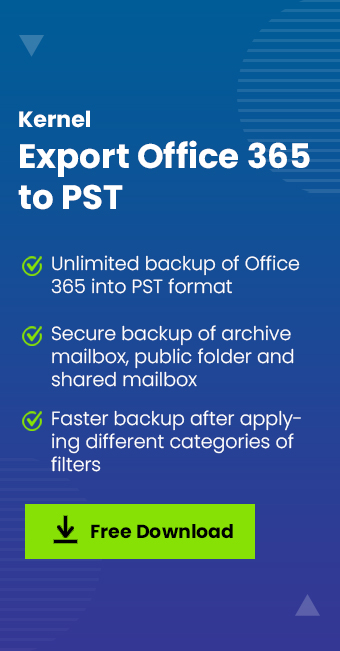Read time: 8 minutes
Though the concept of remote working is nothing new, the way we work today has changed dramatically. Technology has helped us to connect with each other in ways that were once unimaginable, and now we are able to work from anywhere. But this concept can also create some challenges for employers as well as employees.
We will discuss a few benefits, and some challenges associated with remote working. We will also see how Office 365 can help overcome them. Stay tuned!
Benefits of working remotely with Office 365
Microsoft 365 is more than just a set of productivity tools–it is a platform that can help firms of all sizes achieve their goals. It is quite helpful in eliminating the difference between work from home and work from office environment. It is embedded with a set of productivity tools like Excel, Word, OneDrive, SharePoint, etc. in their latest version. Here are some of the benefits of working remotely with Office 365.
- Access to mailboxes: With Microsoft 365, you can manage and access your mailbox data like email, calendar, and contacts from anywhere and on any device. This means you can stay connected even when you are away from the office.
- Data security: Data security is one of the major concerns when working remotely. Office 365 offers data encryption accompanied by multi-factor authentication, adding an extra layer of protection to the data. The compliance features available to support organizations in meeting regulatory compliances and maintaining confidentiality.
- Enhanced productivity: Working remotely with Office 365 tools can help you be more productive. With Office 365, anybody can work from anywhere, at any time. You can also set up your work environment to suit your needs, which can help boost your productivity.
- Connectivity with co-workers: One of the common challenges of remote working is feeling isolated and lonely without your co-workers. However, with Office 365 tools and applications like Teams, SharePoint, etc., you can easily stay connected with your team. Use instant messaging to chat in real-time, video conferencing to meet face-to-face, and team sites to share information and collaborate on projects.
- Savings on time and money: Working remotely can save you time and money. And with Microsoft 365, you can eliminate the travel and accommodation costs. You can save a lot of time that’s otherwise wasted unnecessarily by avoiding traffic and working in a more flexible environment.
Remote working challenges
The challenges coming with remote working can be broadly classified into three main categories: technical, human, and organizational. Let’s go through them all one-by-one and learn how we can overcome them.
Technical challenges of working remotely with Microsoft 365
Remote working with Office 365 offers a lot of technical challenges like lack of necessary resources, and it is crucial to overcome them on time for smooth coordination. Here are a few of them:
- Ensuring a reliable internet connection: One of the most common technical challenges of working remotely is ensuring you have a reliable and secure internet connection. This is essential to access the tools and resources from the Office 365 suite to do your job.
- Managing device compatibility issues: Another technical challenge you may face when working remotely is device compatibility issues. This can be a critical issue if you are using a device that is not compatible with the software or hardware you use for your job.
- Dealing with technical difficulties: Another challenge you may face when working remotely is dealing with technical difficulties. This can include anything from having trouble logging into your account to dealing with software or hardware issues.
Human challenges offered by remote work with Office 365
Human induced challenges while working remotely include communication issues, time management, and others. Let’s look at them in detail:
- Managing work-life balance: One of the most common human challenges of working from home is managing work-life balance. It will not be easy for one to strike a balance between work and life when you are working from home.
- Staying motivated and focused: Another human challenge of working in a remote setup is staying motivated and focused. One can easily get distracted when you are working from home, which can make it difficult to get work done.
- Dealing with isolation: When you work remotely, you need to deal with isolation. This can be an issue if you are not used to working by yourself or if you do not have much contact with other people during the day.
Organizational challenges of remote work
Some challenges that organizations encounter while offering remote work setup includes the following:
- Creating structure and routines: One of the most common organizational challenges of working in a remote setup is creating structure and routines. It is hard to stay on track and get work done when you are not in an office environment.
- Managing communication: Another organizational challenge of remote working is managing communication. The challenge is to keep everyone on the same page when you are not all in the same place.
- Ensuring team cohesion: Managing remote teams is also a challenge. It can be difficult to build and maintain relationships with your team members when you are not working face-to-face. You might need to engage in regular meetings and calls over Teams.
Overcome remote working challenges with Office 365 Tools
So, how can you overcome the challenges of working remotely with Office 365 tools? Here are some tips:
- Keeps data synchronized across devices –One of the advantages of Office 365 tools is that they allow you to synchronize data across all your devices easily. This means that you can start working on a document on your laptop and then resume where you left off on another device tablet or smartphone. To do this, simply sign in to your Microsoft 365 account on all your devices and make sure that the “Sync” setting is turned on.
- Deals with application or software glitches: Another common issue is dealing with application or software glitches. This can be due to a number of things, such as incompatible versions of software or outdated drivers. Office 365 overcomes this by making sure that you always have the latest version of all the software and apps installed on your devices. Moreover, it is advisable to export emails from Office 365 to Outlook for your convenience.
- Connecting with colleagues and co-workers: One of the main advantages of working in an office is the ability to easily connect with colleagues and co-workers. However, this can be more difficult when working remotely. To overcome this, make sure you stay in touch with your team using communication tools like Skype for Business or Microsoft Teams. You can also try attending virtual networking events or joining online communities related to your industry.
These are some challenges you may face when working remotely with Office 365 tools. While they may seem daunting, there are a number of things you can do to overcome them, as discussed above. Moreover, here are some Office 365 Collaboration tools to sort out all your problems.
Office 365 collaboration tools
There are a variety of different Office 365 collaboration tools available, each designed to help teams work together more effectively.
- SharePoint Online: SharePoint Online is a cloud-based document management and collaboration platform. It allows users to securely store, share, and edit documents online. SharePoint offers additional capabilities such as team sites, enterprise content management, and social networking.
- Skype for Business: It is a communication and collaboration tool features like instant messaging, video chat, and audio calls. Skype for Business also offers features such as screen sharing and web conferencing.
- Yammer: Yammer is an enterprise social networking platform. It allows users to create groups, post updates, and share files. Yammer provides attributes such as integration with other Office 365 apps and tools and mobile apps.
- Office 365 Groups: Office 365 Groups is a collaboration tool that allows users to create and manage groups of people. Groups can be used for project management, brainstorming, or interaction between colleagues. Office 365 Groups even can add members from outside your organization and offer integration with other Office 365 apps and tools. Further, what if your Office 365 Groups become inaccessible, no problem! We are here to help you recover deleted Office 365 groups.
- OneDrive for Business: OneDrive for Business is a cloud-based storage platform. It allows you to store documents, photos, and other files online. Moreover, OneDrive has features such as file sharing, version control, and synchronization.
- Exchange Online: Exchange Online is a cloud-based email and calendaring platform. It allows sending and receiving emails, scheduling meetings, and setting up tasks and reminders. Exchange also offers features for accessing email from mobile devices and integrating with other Office 365 apps and tools.
Remote working priorities to consider for your business
- Security: When you are allowing employees to work remotely, it is important to consider security. You will need to implement governance and compliance policies and procedures to help keep your data safe and secure.
- Productivity: Another important consideration when allowing employees to work remotely is productivity. You will need to make sure your employees are able to stay productive when working from home. There are many advanced tools and strategies you can use to help with this.
- Communication: When employees are working remotely, it is important to make sure they can communication with the rest of the team. There are a number of communication tools available in Office 365, such as Skype for Business and MS Teams, which can help with this.
- Flexibility: Finally, when you are implementing remote working policies, it is important to be flexible. Employees’ needs will vary, and you will need to make sure your policies are able to accommodate these differences.
How to take Office 365 backups?
After setting up and got through your challenges using Office 365, it is quite important to keep all your data backed up in one place. You can have security, synchronization, accessibility, and storage in one place with the Kernel Export Office 365 to PST. With this software, you can take an unlimited backup of your data.
You can also use the built-in CSV file to automate the whole backup process. The smart filters in the software allow you to choose specific selective data based on Date, Folder, Item Type, and more. Also, the tool saves the complete folder hierarchy separately in a different folder. This tool makes it easy to access the required data later and not losing it in case of emergencies. Thus, this backup software provides many features that make it an ideal choice for backing up your Office 365 data.
Final Thoughts
If you want to offer more flexibility to your employees while ensuring the security of your company data and systems, remote working with Office 365 could be the solution. With proper planning, you can overcome the challenges of remote work and reap the benefits of a productive and content workforce. Office 365, with its user-friendly interface, is a valuable tool that can help you maintain data security while working from anywhere in the world.








